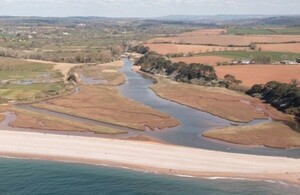Working with nature to reduce flood and erosion risks
Evidence base on natural flood management is supporting investment decisions and informing which measures to use.

Saltmarsh creation at Lower Otter. Image credit: Environment Agency.
Working with natural processes evidence directory
Lydia Burgess-Gamble1 and Daniel Hine 1
1 Environment Agency, United Kingdom
A key resource for natural flood management (NFM) stakeholders in the UK is the Working with natural processes evidence directory (WWNP). NFM seeks to protect, restore, and mimic the natural functions of catchments, floodplains, rivers, and coasts to reduce flooding and coastal erosion. The internationally recognised evidence directory captures what the research says about the benefits of NFM as well as providing case studies and opportunity maps. The Environment Agency first published it in 2017 with an update in 2024.
The 2024 edition, informed by more than 700 research papers, summarises the latest evidence for 17 measures relating to river and floodplain, woodland, run-off, and coast and estuary management. Evidence of NFM has grown in recent years, building confidence in the flood risk reduction and wider benefits these approaches can bring. The updated evidence base shows that flood risk reduction and wider benefits vary across measures. It helps us to understand what works best where. It also tells us there is still more to learn about NFM, but the research gaps are closing and are more detail-orientated.
Impact
Growing evidence on the effectiveness of NFM has had a transformative impact on flood risk management across the UK, helping to support investment in natural solutions to increase society’s resilience to flooding, coastal erosion and climate change.
The evidence base underpinned the design of the Environment Agency’s £25 million fund for Natural Flood Management. The fund was announced in 2023 and runs until March 2027. It aims to reduce local flood risk while providing wider benefits to the environment, nature and society. It will accelerate new and existing opportunities to implement and fund NFM and fill knowledge gaps in the evidence base. It is benefitting 38 projects, overseen by a range of organisations.
Following the 2017 publication, the Natural Environment Research Council (NERC) invested £4 million from 2017 to 2022 through the NERC natural flood management programme. Projects funded by the programme helped to address some of the research gaps identified in the 2017 evidence directory and informed the updated version.
The research findings from the 2017 evidence directory were also used by project teams to support NFM design within the Natural Flood Management Pilot Programme that ran from 2017 to 2021 and funded 60 projects. Learning from the pilots helped to inform the 2024 evidence base by demonstrating that NFM measures used in combination across a large area could provide flood risk reduction benefits through reduced runoff and increased water storage, in addition to other learning. It was estimated that the NFM Pilot Programme created 1.6 million cubic metres of water storage which is about the equivalent of around 670 Olympic size swimming pools (Environment Agency, 2022).
The WWNP evidence directory has supported local NFM projects in their design and selection of measures.
It was referenced as a key resource to the Slow the Flow project in Calderdale. At Hardcastle Crags (Hebden Bridge) the charity group installed over 800 leaky barriers. Their research has shown that natural flood management measures can slow high water levels in a flood by between 30 and 105 minutes downstream.
The research also helped Stroud District Council to choose the most effective locations for floodplain reconnection as part of the Stroud Natural Flood Management Project. This project is thought to reduce flood risk to about 12 properties and has inspired discussion about further works.
The evidence directory enabled the Shipston Area Flood Action Group to have meaningful community and landowner discussions as part of their Natural Flood Management Project in Shipston-on-Stour. These successful discussions led to agreements and the installation of more than 850 natural flood management features including leaky wooden barriers, ponds, bunds, river restoration and tree planting. The project is thought to have reduced flood risk to more than 80 homes.
Beyond the UK, the findings from the evidence directory are widely referenced in the International Guidelines on Natural and Nature-Based Features for Flood Risk Management, an international guide produced by the US Army Corps of Engineers (USACE).
Resources
Environment Agency. (2017). Working with natural processes to reduce flood risk. Available at: https://www.gov.uk/flood-and-coastal-erosion-risk-management-research-reports/working-with-natural-processes-to-reduce-flood-risk (Accessed: 25 March 2025).
Environment Agency. (2021). Natural Flood Management Programme: initial findings. Available at: https://www.gov.uk/government/publications/natural-flood-management-programme-initial-findings (Accessed: 25 March 2025).
Environment Agency. (2022). Natural Flood Management Programme: evaluation report. Available at: https://www.gov.uk/government/publications/natural-flood-management-programme-evaluation-report (Accessed: 25 March 2025).
Environment Agency. (2025). Working with natural processes to reduce flood risk 2024, Available at: https://www.gov.uk/flood-and-coastal-erosion-risk-management-research-reports/working-with-natural-processes-to-reduce-flood-risk-2024 (Accessed: 25 March 2025).
UK Research and Innovation (UKRI). (2024). Driving policy innovation over decades: natural flood management. Available at: https://www.ukri.org/ (Accessed: 25 March 2025).
Funder
The research project was funded by the Flood and Coastal Erosion Risk Management (FCERM) research and development programme.
Collaborators
- Environment Agency (EA)
- Department of Environment, Food and Rural Affairs (Defra)
- Natural Resources Wales (NRW)
- Welsh Government
- Scottish Environment Protection Agency (SEPA)
- JBA Consulting
- English Severn and Wye RFCC
- Forest Research
- HR Wallingford
- Natural England
- River Restoration Centre
- Woodland Trust
- CH2M Hill
- James Hutton Institute
- Lancaster University
- Newcastle University
Research period
- 2017 to 2024
Impact period
- 2017 - ongoing
Impact country
- England
- Wales
- Scotland
Contributing to areas of research interest
- 8 - Integrated outcomes